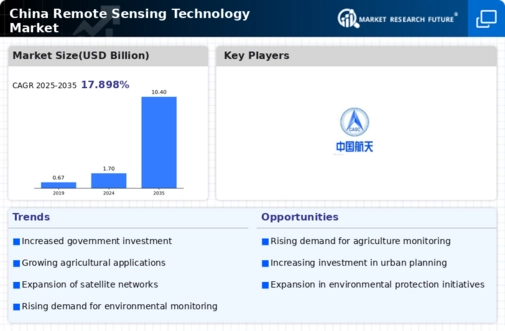Growing Demand for Geospatial Data
The demand for geospatial data in China is escalating, significantly impacting the remote sensing-technology market. Industries such as agriculture, urban planning, and environmental management increasingly rely on geospatial data for decision-making. According to recent estimates, the geospatial industry in China is projected to reach a value of approximately $20 billion by 2026, reflecting a compound annual growth rate (CAGR) of around 15%. This growing demand is driven by the need for accurate and timely information to support sustainable development and resource management. Consequently, companies in the remote sensing-technology market are focusing on developing innovative solutions to meet this rising demand.
Expansion of Smart City Initiatives
The rise of smart city initiatives in China is significantly shaping the remote sensing-technology market. Urbanization has led to increased pressure on infrastructure and resources, prompting cities to adopt smart technologies for better management. Remote sensing technologies play a vital role in urban planning, traffic management, and environmental monitoring. For example, cities like Shenzhen are utilizing remote sensing data to optimize public transport systems and enhance urban resilience. The Chinese government has allocated substantial funding for smart city projects, which is expected to boost the remote sensing-technology market as cities seek innovative solutions to improve livability and sustainability.
Rising Investment in Defense and Security
Rising investments in defense and security applications are also driving the remote sensing-technology market in China. The government recognizes the strategic importance of satellite imagery and remote sensing data for national security and military operations. Enhanced surveillance capabilities and reconnaissance are critical for monitoring borders and assessing potential threats. Recent reports indicate that defense spending in China is projected to increase by 7% annually, with a significant portion allocated to advanced technologies, including remote sensing. This focus on defense applications is likely to propel growth in the remote sensing-technology market, as the demand for high-resolution imagery and real-time data continues to rise.
Increased Focus on Climate Change Mitigation
China's commitment to addressing climate change is influencing the remote sensing-technology market. The government has initiated various programs aimed at monitoring environmental changes and assessing the impact of climate policies. Remote sensing technologies are crucial for tracking greenhouse gas emissions, deforestation rates, and land-use changes. The Chinese government aims to reduce carbon emissions by 30% by 2030, which necessitates robust monitoring systems. This focus on climate change mitigation is likely to drive investments in remote sensing technologies, as accurate data is essential for evaluating the effectiveness of environmental policies and initiatives.
Technological Advancements in Satellite Systems
The remote sensing-technology market in China is experiencing a surge. This growth is due to rapid advancements in satellite technology. Enhanced imaging capabilities, improved resolution, and increased data collection efficiency are pivotal. For instance, the launch of high-resolution satellites has enabled more precise monitoring of agricultural activities, urban development, and environmental changes. The Chinese government has invested heavily in satellite technology, with plans to deploy a constellation of satellites that could increase data availability by up to 30% by 2027. This technological evolution not only supports various sectors such as agriculture and forestry but also enhances disaster management and urban planning, thereby driving the remote sensing-technology market.












Leave a Comment